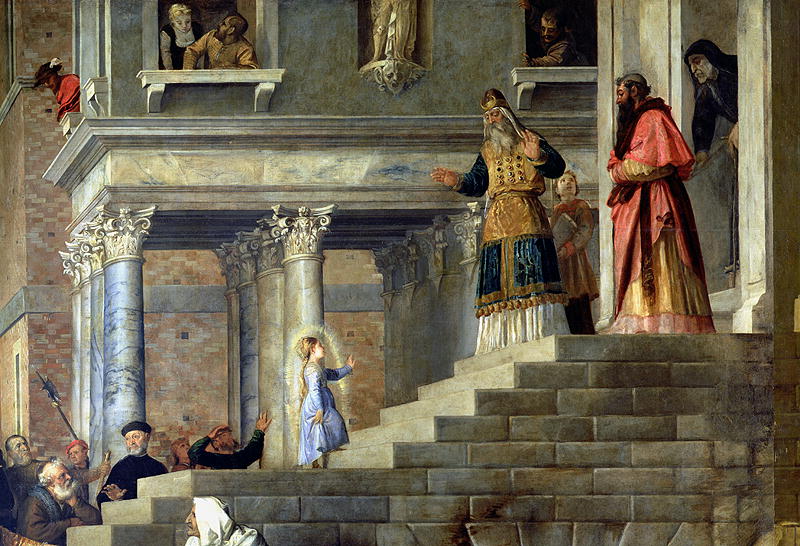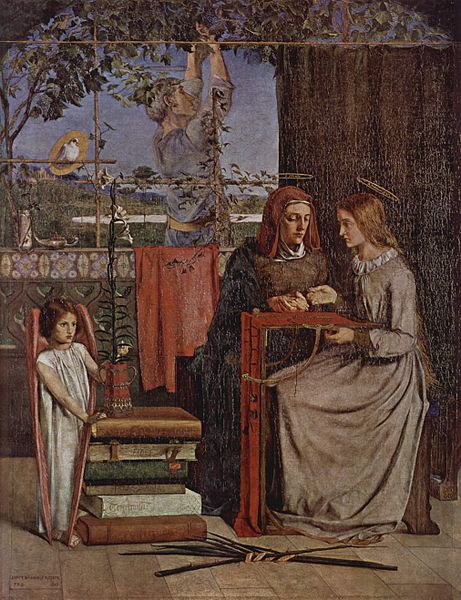It is not known precisely where or when Mary was born. At the age of three, her parents to gave her to the temple, so most of her girlhood was spent away from her family. This must have been a difficult and possibly lonely way to grow up.
According to Christian theology, Mary was visited by the Archangel Gabriel, who told her that she was pregnant with the son of God. Mary was only fourteen at the time and recently betrothed to Joseph. They continued with their marriage and, while pregnant, relocated to Bethlehem — where Jesus was born. She would go on to become ‘blessed among women,’ living a long life and becoming the ideal Christian mother. Accounts of her life after Jesus’s birth are conflicting. In some, she is witness to many events in his life, including the first miracle. Other accounts suggest conflict between her and Jesus, possibly culminating in Jesus’s family rejecting his message and public ministry. She is also said to have been present at her son’s crucifixion, an event represented in countless artworks. Upon her death, possibly in 41 AD, she was assumed directly into Heaven, an event known as the Assumption.
There is significant diversity in modern beliefs and devotional practices related to Mary, including various beliefs in Christianity and Islam. From the days of the early Christian church to now, Mary has been the subject of many different artworks.

Presentation of the Virgin at the Temple, Titian, 1534-38, Oil on canvas, Gallerie dell’Accademia, Venice. WikiCommons
Titian depicts Mary’s presentation at the temple with her ascending the staircase to a Chief Priest. Titian painted this work for the Scuola Grande di Santa Maria della Carita, now the Academia Gallery of Venice. His personal value as a portraitist is exemplified, as we can see each individual has distinguishing features of minute detail drawn with clear objectivity. Combined, we feel the monumental solemnity of the scene and individual energy of each figure.
The painting depicts Mary as a very young girl in stark drama, isolation, and beauty through vibrant color and detail. She is seen ascending the steps, enveloped in a halo of holy light as she reaches out for the high priest and is welcomed to the temple. Mary appears almost as if on a stage: the audience below her, the Chief Priest above her. Her center location emphasizes that she, despite being so little, is the main focus of the work. She is surrounded by scenes of everyday life: dignitaries, a mother holding her baby, aristocrats and commoners.
Mary is also emphasized as leaving these everyday moments for a higher purpose, signified by the high priest, grandly dressed and awaiting her arrival. Yet Mary still appears small and fragile — courageous, but alone and young. The high priest awaiting her extends his arms, seeking to welcome Mary into the loving environment of the temple.
Titian wasn’t just saying something about Mary — he was saying something about the Scuole. At the time, the Scuole served Venetian merchants. When a merchant was ruined and abandoned, or his family was left destitute, the Scuole supported them. Like Mary, disgraced merchants and their families had to ascend the steps to the temple alone, seeking the grace that awaited them.
Titian also emphasized the architecture in the painting, mirroring the architectural details of the gallery in which is was displayed. His use of Greek columns and a landscape of high mountains serve to emphasize the importance and magnitude of the scene — Mary’s arrival at the temple will be a defining moment of her life and for all Christians. The painting is a remarkable example of naturalistic detail and Titian’s influence from theatre.
One interesting detail is the old woman in front of the stairs. She is off-scale with the rest of the painting and appears as an outsider to the story. Some art historians believe that this old woman may be Titian — a self-portrait of the artist viewing the scene. Compared to portraits of Titian, the resemblance is remarkably similar.
You can view the Restoration of Titian’s work in this video from SaveVenice.org, which helps showcase the scale of the painting as it hangs.

The Girlhood of Mary Virgin, Dante Gabriel Rossetti, 1849, Oil on canvas, Tate Gallery, London. Source: WikiCommons.
The Girlhood of Mary Virgin is another painting depicting Mary’s early life, perhaps within the temple. This was Rossetti’s first major oil painting, exhibited as an announcement of the arrival of a new movement in British art, the “Pre-Raphaelite Brotherhood” (“PRB”). Attached to the painting were two sonnets — one a translation of iconographical details, the other a liberalization of its Catholic symbology. The sonnets served as Rossetti’s own commentary of his work.
Unfortunately, Rossetti was amiss in giving this painting as an example of the PRB — it was too literal and far less meticulous than other works in the movement. Rather, Rossetti was using elements of primitive Christian art meant to recover the spirit of a lost world. Like his depiction of Mary, Rossetti aimed to become caught up in the mysterious and divine.
The Girlhood of Mary Virgin is simultaneously an attempt for historical representation and medieval religious symbolism. Drawing on his love for medieval representations, we see Mary seated indoors with her mother, St. Anne, while her father, St. Joachim, works outside. Mary is performing embroidery, traditional women’s work. Other painters had depicted Mary’s education with Mary reading from books, and Rossetti thought this inaccurate for the historical time in which she lived. This is reflected in the painting’s accompanying sonnets, in which Rossetti describes Mary as having “simpleness of intellect And supreme patient. From her mother’s knee Faithful and hopeful; wise in charity; Strong in grave peace; in duty circumspect.”
Depictions of Mary are often rife with symbolism and Rossetti’s The Girlhood of Mary Virgin is no different. Outside the window, Mary’s father prunes a vine. Hidden in this vine is a cross, and the vine itself alludes to the True Vine (Jesus). Inside, young Mary works on an embroidery with her mother. Her embroidery is an allusion to the robe of Christ’s passion. The rose and lily are Mary’s flowers, as they represent her purity. The palm branch on the floor and the briar rose on the wall allude to Mary’s “great sorrows and her great reward.” Even the colors of the painting are symbolic, echoing the virtues of hope, faith, and charity displayed in the titles of the books.
